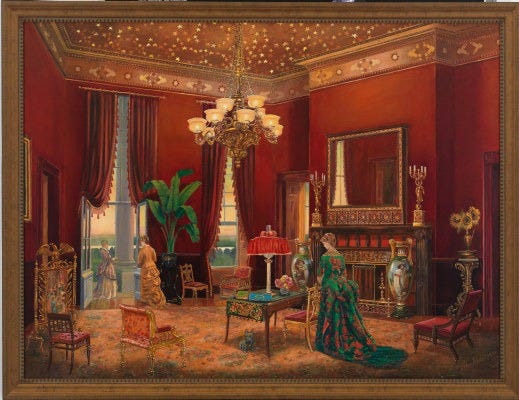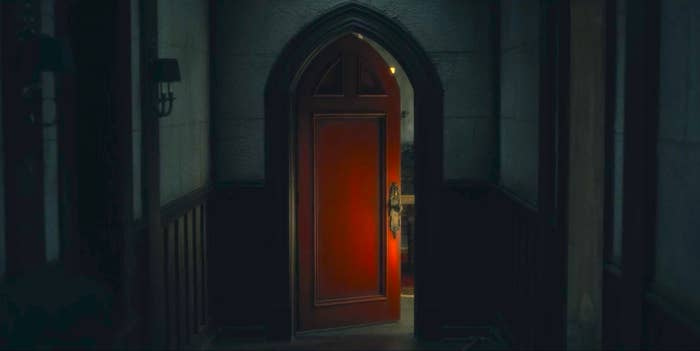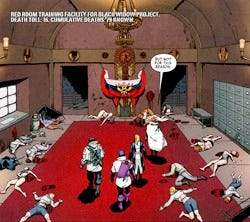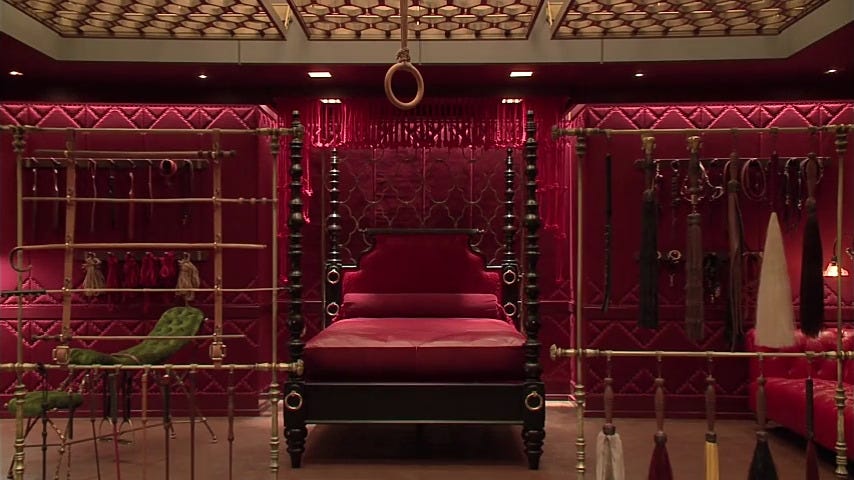Jane Eyre's Red Room
Where did Charlotte Bronte get the idea of the Red Room from? Plus some thoughts on what the Red Room inspired others to create
Shruti and I recently discussed Jane Eyre by Charlotte Brontë on The Novel Tea podcast (you can listen to the full episode here). Jane Eyre gave us many things; the famous Mr. Rochester, one of the greatest plot twists in classic literature, a complex female protagonist, and social commentary still relevant today. However, my favorite takeaway from this novel is the Red Room.
I’d like to point out that all content in this post is speculated based on my deep dive into the subject, and none of this information has been confirmed. This is just for fun! Also, this newsletter is long and may be cut off if you are reading by email. You can click “view entire message” to keep reading via email, or you can visit the newsletter on Substack to view the entire newsletter.
The Origins of the Red Room
The earliest mentions of the word “red room” come from 1808, from James Peller Malcolm's book Anecdotes of the Manners and Customs of London during the Eighteenth Century. The book describes London society in the 18th century, and one of the passages mentioning a red room describes its location within a castle.
Based on this and other sources, it seems that in the 19th century, it was not uncommon to have a “red room” be a part of high-class estates. The use of the red room ranged from being an alternate sitting room, guest room, or a salon.
One of the earliest and most well-known examples of a red room is in the White House. The room existed in many early blueprints of the structure, and its use varied from being the President’s Antechamber, a venue for small dinner parties, and to the First Lady’s salon. In 1845, the room was officially named the “Red Room” after it was furnished with green and red decor by President James K. Polk and First Lady Sarah Polk.

Charlotte Brontë's Inspiration
In 1838, Charlotte Brontë’s sister, Emily Brontë, taught at Law Hill School in West Yorkshire. Nearby, Shibden Hall was a building that was said to be one of the inspirations for Thrushcross Grange in her novel, Wuthering Heights. Its proximity to the school where Emily Brontë spent much time, as well as possible interactions with the young woman who inherited Shibden Hall, Anne Lister, it is probable that she could have pulled elements of this estate into her own story. 1
Anne Lister was an English diarist, well-known for her lesbian relationships in the 19th century, and was famously named “the first modern lesbian”. Anne Lister and Ann Walker were married in Holy Trinity Church, Goodramgate, York, which is now celebrated as the birthplace of lesbian marriage in Britain. 2 Soon after, they moved in together at Shibden Hall. However, this may have been too much for Ann Walker, who in contrast, struggled with her sexual identity and was often anxious and depressed.
Sat by her on the sofa, both of us perpetually with silent tears trickling down our cheeks. She quite undecided, fearing she should not be so happy with him as she might have been. Never knew till now how much she was attached to me ... Torturing herself with all the miseries of not knowing what to do, she said how beautifully I behaved ... She said there was as something in me she liked better than in him. Felt repugnance to forming any connection with the other sex.
Now, let’s get back to how this relates to Jane Eyre. Shibden Hall has a room called the Red Room. It was named after the red Celtic design frieze that runs around the walls.3

After Anne Lister died in 1840, Ann Walker locked herself in this room for so long, that they had to remove the door off its hinges. Soon after, she was taken to an asylum and never returned to Shibden Hall. This would have happened around the same time that Emily Brontë was making visits to the estate, and Charlotte Brontë could have visited the hall herself, or at least heard through close family and friends about the incident. Charlotte Brontë published Jane Eyre in 1847, so this event could have very well inspired the haunted and traumatic Red Room that Jane would experience in her novel.
Inspirations from The Red Room
Since the release of Jane Eyre, the Red Room has become a symbol of struggle, isolation, oppression, and even torture. There are many different interpretations of the Red Room and it has become a source of inspiration in other media and literature. I have scoured my memory as well as the internet to read and understand different examples of the Red Room that I think may have some connections to Jane Eyre.
The Red Room by H.G. Wells
H.G. Wells released a gothic short story called The Red Room in 1894. The main character feels inclined to spend a night in the infamous “Red Room” located in Loraine Castle. Despite multiple warnings against this idea, he proceeds to enter the haunted room and prepares for the night. As time passes, the room becomes exceedingly eerie, and the efforts from the main character to calm himself in the situation ultimately fail, and he passes out from fear.
There are multiple obvious reasons why I think this book was inspired by Jane Eyre (the title, the haunted room, the fainting, etc.), but this quote from the book reminded me of Thornfield Hall:
There were other and older stories that clung to the room, back to the half-incredible beginning of it all, the tale of a timid wife and the tragic end that came to her husband’s jest of frightening her.
The Haunting of Hill House (Netflix)
This section of the newsletter contains spoilers for this Netflix show, skip ahead to the next section if you need to!
The Haunting of Hill House is a Netflix show directed by Mike Flanagan and is loosely based on a book called The Haunting of Hill House by Shirley Jackson. In this adaptation, Hugh and Olivia move into Hill House with their five children in an attempt to flip it and sell it, in order to build their dream home. During their stay, they experience paranormal phenomena and eventually have to flee their house. Almost thirty years later, the siblings are forced to confront how these events affected their lives.
During the flashbacks of their childhood at Hill House, the siblings are hellbent on unlocking the door to a hidden room in the attic that they call “The Red Room”. There seem to be shadows lurking inside the room, and some unseen force pulling everyone into darkness when they are near the room. It is revealed finally, that the Red Room has invaded all their lives in some way or the other throughout their stay, even though the door has always been locked. My interpretation was that the Red Room could wander throughout the house. We see the siblings all have their personal uses for the room without even knowing that they were in the room, to begin with. It acted as a safe space but was tricking the minds of all the inhabitants of the house to consume them.
This idea gives way to the symbol of oppression and haunting from Jane Eyre. The Red Room in Jane Eyre is said to be haunted by her dead uncle, where she has convinced herself that she has seen his ghost and faints from fear. Reading this book knowing that during this chapter, Jane is just a child, it’s easy to write off this experience as immature and irrational because she’s so young. I think this is further explored in The Haunting of Hill House, as all the children experience these paranormal events but it is not fully believable to the audience or older characters because of their age.
The Red Room from the Marvel Universe
The Red Room is something that is mentioned in passing throughout many Marvel movies, but most recently in Captain America: Brave New World. In the Marvel comics, the Red Room has different uses and origins, but I think the story of the Black Widow’s Ops Program closely references Jane Eyre.
The Red Room recruits orphan girls to become undercover agents to be used as spies for war, assassination, and power. The room uses technology to imprint the orphan girls with fabricated memories, making them believe that they were trained in ballet at the Bolshoi Theatre.4 They also receive medical treatment that allows them to remain young and even have superhuman abilities.
The children being orphan girls, as well as this room being a clear traumatic memory in these girls when we see them out in the world as grown-ups, are clear parallels to Jane Eyre that are impossible to ignore. I think it’s interesting to bring memory into both examples as well because in Jane Eyre we are reading this book in first person narration from the perspective of future Jane. We are meant to believe that Jane is a reliable narrator, but it is curious to analyze the book with the idea that she may have selective or distorted memories based on trauma.
The Amityville Horror by Jay Anson
The Amityville Horror is a book based on true events that occurred in 1974 in a town called Amityville, on the south shore of Long Island, New York. The original story has created an entire franchise of books and movies with similar horror themes.
In 1974, Ronald DeFeo Jr. shot and killed six members of his family in his home at 112 Ocean Avenue. He was eventually sentenced to prison, and in 1975, a couple named George and Kathy Lutz moved into the house with their three children. Upon their first month of living here, they claimed to have been terrorized and haunted by unknown forces residing in this home.
During their short stay, they came across a small room in the basement with red walls that they dubbed the Red Room. I’ve seen some speculation that it is called a red room because it sounds like Redrum, an anagram for murder. However, I don’t know if I am on board with this theory, my thought is that this was an old gothic house that had a room named so because of the 19th-century style room usage that I mentioned earlier. Or maybe it is as simple as the fact that the walls were painted red.
I am not fully invested in this example of the Red Room having a connection with Jane Eyre, but I thought it was worth mentioning. After this story became popular, I think a red room turned more into a horror trope than having any deeper meanings.
Fifty Shades of Grey by E.L. James
What seems like a professional and innocent interview with literature student Anastasia Steele and young entrepreneur Christian Grey, develops into a passionate love affair. The timid Ana slowly starts to realize her feelings for this man and also uncovers his darkest secrets that complicate their relationship.
How on earth does this steamy, erotic romance novel have anything to do with the classic literature of Jane Eyre? Maybe it’s nothing, but strangely enough, Christian Grey’s sex dungeon is called the “Red Room”. On the surface, this could be a coincidence because red is the color of passion and romance, so it was translated to the room where Grey performs his dark desires. However, digging deeper into this analysis, Anastasia is a character with almost no contact with her immediate family, she falls for a man who is in a completely different class and age than she is, and there is involvement with a crazy ex-girlfriend. Is Fifty Shades of Grey a modern and erotic retelling of Jane Eyre?
Up Next
Tomorrow, we’ll be analyzing Jane Eyre even more through a retelling: Wide Sargasso Sea by Jean Rhys — not, as Shruti mistakenly said last week, Rebecca. (sorry y’all! The various timelines of planning, recording, promoting, and publishing our podcast episodes gets confusing sometimes. But rest assured it is coming soon!)









Wow, really enjoyed this! Your analysis of the Red Room in the Haunting of Hill House is great - I'll have to rewatch it now with the idea that the Room moves throughout the House.
Very interesting! Such simple yet effective symbolism.